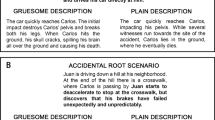Abstract
The verdict in all criminal cases is heavily reliant on judge’s decision-making abilities. This, in turn, may be influenced by arguments from the litigating lawyers, eyewitness testimony, and comments from the arbitration panel; however, the lawyers are reported to generally hold maximal influence. This chapter will outline the various factors that influence the judges’ decision-making process. We will discuss at length on psychological concepts such as short-term memory, schemas, language, emotions, persuasion, and their role in courtroom. In discussing various examples of the effective courtroom statements derived from international and Indian trials, we will also outline the various ways in which lawyers can successfully persuade a judge in the courtroom.
Access this chapter
Tax calculation will be finalised at checkout
Purchases are for personal use only
Similar content being viewed by others
References
Blanck, P. D., & Rosenthal, R. (1992). Nonverbal behavior in the courtroom. Applications of nonverbal behavioral theories and research, 89–115.
Bornstein, P. R. (2009). Persuading a cold judge. Litigation, 35(2), 27–31.
Costopoulos, W. C. (1972). Persuasion in the courtroom. Duquesne Law Review, 10(3), 392–393.
Cromwell, H. (1950). The relative effect on audience attitude of the first versus the second argumentative speech of a series. Speech Monographs, 17(2), 105–122.
Darabont, F. (1994) The Shawshank Redemption (n.d.). Retrieved November 29, 2019, from http://www.dailyscript.com/scripts/shawshank.html
Gold, V. (1987). Covert advocacy: Reflections on the use of psychological persuasion techniques in the courtroom. North Carolina Law Review, 65(3), 495.
Hart, A. J. (1992). On the sobriety of judges: Nonverbal influence in the courtroom.
Kohler, C. (2007) Order Effects Theory : Primacy versus Recency. Center for Interactive Advertising, The University of Texas at Austin. Retrieved 2007–11–04.
Lubet, S. (1997). Persuasion at trial. American Journal of Trial Advocacy, 21(2), 342–343.
Lund, F. H. (1925). The Psychology of Belief: IV. The Law of Primacy in Persuasion. The Journal of Abnormal and Social Psychology, 20, 183–191.
Miller, M. O., & Mauet, T. A. (1998). The psychology of jury persuasion. The American Journal of Trial Advocacy, 22, 549.
Miller, N., & Campbell, D. T. (1959). Recency and primacy in persuasion as a function of the timing of speeches and measurements. The Journal of Abnormal and Social Psychology, 59(1), 1–9. https://doi.org/10.1037/h0049330
Reed, K., & Bornstein, B. H. (2018). Objection: Psychological perspectives on jurors’ perceptions of in-court attorney objections. SDL Rev., 63, 1.
Sannito, T (1981). Psychological courtroom strategies, TRIAL DIPL. J., Summer, 30.
O. J. Simpson Murder Trial (1995). The O.J. Simpson murder trial: Excerpts of opening statements by Simpson Prosecutors. (1995, January 25). Retrieved from https://www.latimes.com/archives/la-xpm-1995-01-25-mn-24229-story.html
Voss, J. (2005). The science of persuasion: An exploration of advocacy and the science behind the art of persuasion in the courtroom. Law and Psychology Review, 29, 306.
Author information
Authors and Affiliations
Editor information
Editors and Affiliations
Rights and permissions
Copyright information
© 2021 The Author(s), under exclusive license to Springer Nature Singapore Pte Ltd.
About this chapter
Cite this chapter
Junnarkar, M., Adlakha, K. (2021). Decision-Making in the Courtroom: Judiciary. In: Sahni, S.P., Bhadra, P. (eds) Criminal Psychology and the Criminal Justice System in India and Beyond. Springer, Singapore. https://doi.org/10.1007/978-981-16-4570-9_15
Download citation
DOI: https://doi.org/10.1007/978-981-16-4570-9_15
Published:
Publisher Name: Springer, Singapore
Print ISBN: 978-981-16-4569-3
Online ISBN: 978-981-16-4570-9
eBook Packages: Law and CriminologyLaw and Criminology (R0)




